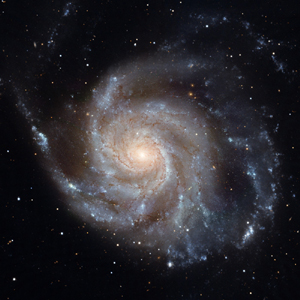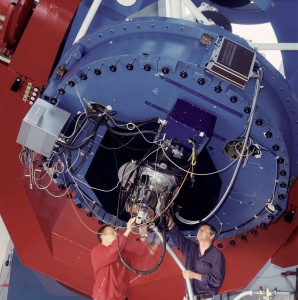Creation Corner
Dark matter: where is it?

Astronomers at last looked hard for dark matter in our own Galaxy. Surprise! They didn’t find it. Every current theory says that the Milky Way should have its own halo of dark matter, like every other large object in the sky. But the Milky Way has no dark matter. Maybe the “astronomical community” should admit that dark matter does not exist.
Dark matter, dark energy, and the Big Bang
Sometimes astronomers see large objects spinning faster than they should, at least for the mass that the astronomers can see. Astronomers calculate two kinds of mass for a galaxy or a larger object:
- Luminous mass gives off light (or ultra-violet light, X rays, etc.) that humans can see with a telescope or other sensor.
- Dynamical mass pulls on other objects with gravity and makes them spin faster when in orbit.
On earth, and in our solar system, luminous and dynamical masses are the same. But in many objects beyond our galaxy, dynamical mass is more than luminous mass. Astronomers call the difference dark matter. Jan Oort (of “comet cloud” fame) first suspected that our own galaxy had twice as much dynamical mass as luminous mass. Fritz Zwicky looked at the Coma supercluster and decided that it had ten times as much dynamical mass as luminous mass.
Astronomers coined the phrase dark matter to explain the discrepancy. Conventional astronomers now guess that the universe has four times as much dark matter as normal “light matter.” (Astronomers speak of still another intriguing concept, dark energy, to explain why the universe seems to expand faster, as if something is pushing it apart and acting against gravity, which ought to pull it in.)
Thus astronomers have suspected since the 1930s that even our own galaxy has more “stuff” in it than they can see, and other galaxies (and larger objects) have even more. According to current theory, every galaxy and larger object has its own ration of dark matter. This matter arranges itself in a halo around the center of the object.

The Wide Field Imager (WFI) is a focal reducer-type camera which is mounted at the Cassegrain focus of the 2.2-m MPG/ESO telescope at La Silla, with field of view of 34'x33'. Credit: ESO/H. H. Heyer, CC BY 3.0 Unported License
The European Southern Observatory operates several ground-based telescopes in South America. Recently they decided to measure how stars move as accurately as they could. Surely, they thought, they could find how much dark matter lies close to our solar system. Our sun stays at least 27,600 light years from the center of the galaxy. So we should be near enough to the halo to see the effects of dark matter close-up. So the ESO decided to have a look. What they found, or rather what they did not find, shocked them.
Where is the dark matter?
The ESO’s press release two days ago expressed that shock. Dr. Christian Moni Bidin (Department of Astronomy, University of Concepción, Chile) said:
The amount of mass that we derive matches very well with what we see — stars, dust and gas — in the region around the Sun. But this leaves no room for the extra material — dark matter — that we were expecting. Our calculations show that it should have shown up very clearly in our measurements. But it was just not there!
This, says Walt Brown of the Center for Scientific Creation, should have surprised no one. In an interview with CNAV, he asked:
Why did they think they would see dark matter from a ground-based telescope, looking at a region around the Sun?…That much dark matter, that close to our Sun, should have affected the motions of the planets and asteroids. And as you know, it does not.
And if it had, astronomers might never have suspected anything like dark matter. They define luminous mass by looking at the Sun, planets and moons, measuring the light they give off or reflect, and assuming that dynamical and luminous masses are the same in our solar system.
The ESO paper gives the details. By looking at how fast our galaxy spins around its center, among other things, they guessed that they should detect at least 0.005 earth mass, and as much as 0.013 earth mass, per cubic parsec. Instead they found: zero, with a tolerance of 0.001 earth mass per cubic parsec. That is four standard deviations lower than what they expect, so the “null hypothesis” (the guess that they “just missed it”) cannot be correct.
The ESO lamented, in effect, “How can we possibly find dark matter ‘particles’ here on earth, when we can’t even find the dark matter that we’re supposed to see in the solar neighborhood?” But they realized something else: they cannot explain why our galaxy spins as fast as it does.
Despite the new results, the Milky Way certainly rotates much faster than the visible matter alone can account for. So, if dark matter is not present where we expected it, a new solution for the missing mass problem must be found. Our results contradict the currently accepted models. The mystery of dark matter has just become even more mysterious.
In fact, this need not be a deep, dark secret.
Dark matter as fudge factor
The first-ever “dark matter” object was a planet called Vulcan, after the god of fire on Mount Olympus. (This is not the same as the fictitious desert world in the 40 Eridani system where a race of point-eared people almost destroyed themselves before deciding that such behavior would be “illogical.”) No astronomer saw this object. Instead, they saw that the planet Mercury moved faster in its orbit, by 43 arc-seconds per century. So astronomers assumed that something was inside the orbit of Mercury, something that, absurdly, kept station on the far side of the Sun from earth. Then in 1915, Albert Einstein solved the mystery. The Sun seems heavier from the point of view of Mercury than it does on earth. The extra weight explains the faster orbit. No object, other than the Sun, sits inside Mercury’s orbit. (And when the Mariner 10 and MESSENGER probes flew by Mercury, they did not see “Vulcan” or any innermost asteroid belt.)
Astronomers should have learned their lesson from the Vulcan affair. They did not. If an object defies physics, by revolving around another object faster than it should, then the physics is wrong, or at least incomplete. Einstein showed this in 1915. And more recently, John G. Hartnett showed the same. In 2006, he proposed a new equation to say how fast a large object should spin. By this equation, the spin rate goes up with the fourth root of mass, not the square root as Sir Isaac Newton originally proposed. This is the Tully-Fisher relation between spin rate and luminous mass, with a hard theoretical basis. And according to this model, dynamical and luminous masses are always the same. So while every other astronomer runs around looking for dark matter, men like Brown and Hartnett could tell them to stop looking. All matter is “light”; none is “dark.”
To get that model, he threw out the Big Bang model. He began with a new model of a universe that expands in direct proportion to the distance from a center. That model is consistent, not with a Big Bang, but a Big Stretch soon after the universe came to be. The problem that the astronomical community has with Hartnett’s model is philosophical. The Bible attests to that “Big Stretch.” (According to Brown, the Old Testament speaks of God “stretching the heavens” eleven times.) Worse yet, Hartnett’s “cosmological relativity” shows that the universe cannot be much older than six thousand years.
Conventional astronomers, in short, make a problem for themselves because they keep trying to avoid God. This week they have rushed into a blind alley. How will they explain “dark matter” that has no local effect on nearby stars, though it keeps our galaxy spinning faster? They plan to launch another rocket probe to find more evidence. What will they do when that probe can’t help them, either?
Related:
- Creation Day Four: The Big Stretch
- Creation Day Four: Age of the Universe
- Accelerating universe: retrospective
[amazon_carousel widget_type=”ASINList” width=”500″ height=”250″ title=”” market_place=”US” shuffle_products=”True” show_border=”False” asin=”1878026097, 0890515077, 0310234697, 0875523382, 0890511586, B002RBHDFK, 0949906689, 0890513600, 089051416X, 0890515050″ /]

Terry A. Hurlbut has been a student of politics, philosophy, and science for more than 35 years. He is a graduate of Yale College and has served as a physician-level laboratory administrator in a 250-bed community hospital. He also is a serious student of the Bible, is conversant in its two primary original languages, and has followed the creation-science movement closely since 1993.
-

 Civilization4 days ago
Civilization4 days agoDC Pipe Bomb Arrest Raises Questions About Christopher’s Wray’s FBI
-

 Civilization5 days ago
Civilization5 days agoThe Legal Logic Behind U.S. Operations Against Narco-Terrorist Networks
-

 Executive5 days ago
Executive5 days agoNewsom’s ‘National Model’ for Homeless Wracked by Fraud
-

 Executive2 days ago
Executive2 days agoWaste of the Day: Obamacare Failed Test, Approved Fraudulent Subsidies
-

 Executive4 days ago
Executive4 days agoWhen You’re in a Hole, Stop Digging
-

 Education3 days ago
Education3 days agoWaste of the Day: Taxpayers Subsidize Football Coach Severance
-

 Civilization3 days ago
Civilization3 days agoPence Calls on Trump To Fire RFK Jr Over Abortion Drug
-

 Civilization2 days ago
Civilization2 days agoWSJ’s Fearmongering Doesn’t Survive Contact With Evidence













So essentially you are arguing that scientists should stop conducting research if it conflicts with some people’s interpretation of the Bible. Maybe other past scientists (such as Galileo or Copernicus) should have also stopped searching for answers and just listened to what religion told them was true.
Stop conducting research? Hardly.
Stop misconstruing the data? Yes.
“Dark matter” violates Occam’s Razor. The only reason anyone keeps that concept in, is to insist on a chance-alone model of the origin of the universe. That is a philosophical imperative, and a downright silly one.
I’m glad you’ve decided to talk about this, Terry. It’s a perfect illustration of the difference between religion and science.
In science, we’ll see a variety of reactions from denial to total acceptance, with the majority taking a position of “Really? Wow – let’s hear more about this and do other experiments to test this new data”.
In religion, we’ll see your sort of reaction: claiming that this one datum proves the totality of modern science wrong.
In other words, my worldview evolves over time according to the latest scientific data; you pick and choose which items of scientific data to believe in order to support your worldview.
In final words; I’m honest and you aren’t.
That’s not what I see. At least, not in origins science. In operational science (“how things work”), that is exactly what you do see. But in origins science, everyone has made up his mind, else they would never be part of the White Smock Fraternity/Sorority.
And what you really mean is that I don’t have to wait too long for you to come up with the latest excuse, the latest fudge, the latest total, inexcusable violation of Occam’s Razor.
I hate to use the term, but ROFL!!! A Christian calling someone out with Occam’s Razor?
The concept you call “god” is the ultimate violation of Occam’s Razor. Remember that the rule’s original formulation was “Entities shouldn’t be multiplied unnecessarily” and your entire belief system is based on some new entity – you call it “god” – to explain the Universe. Any time anybody asks “Well where did god come from then?” we get wooly, non-answers like “Oh he’s always existed” or “He exists ‘outside of time'” that mean nothing.
Science is based on one postulate: that the Universe obeys some set of rules. We should be able to discover most of those rules if we’re clever enough. And before you ask “Who set the rules?” – a reasonable enough question, to be fair, read up on the Many Worlds interpretation of Quantum Theory.
Your world view demands Special Pleading to allow for some entity “outside time”. All mine requires is that “Stuff Happens”.
Which violates Occam’s Razor?
Yours, and only yours.
“Many worlds” also violates Occam’s Razor. Here is your problem: your side keeps having to postulate something, for which no empirical evidence exists, to “fudge” an equation that clearly is not working. So it is with dark matter and dark energy.
We’re not the ones doing the fudging.
You’re the ones doing nothing but fudging!
At least get your story straight. Your boss at Conservapedia, Andy Schlafly, (and don’t tell me he’s a colleague) is a huge fan of Quantum Theory. He uses it to “explain” miracles.
I’ll take Many Worlds and the Anthropic Principle over goddidit any time.
The Anthropic Principle (that the universe works for mankind and is set up that way) is rather inconsistent with Many Worlds, no? It is certainly inconsistent with atheism. The Anthropic Principle says that Somebody set up the universe to work for human beings.
No Terry, it’s the whole point!
The Anthropic Principle “explains” why the values required for human life are exactly what we need by stating that if they weren’t, human life wouldn’t exist. In other words, there could be (and are, if MW is correct) an infinite number of other universes in which humanity doesn’t exist. The AP states – and it’s really not hard to understand – that human life can only exist in a universe capable of supporting human life! Only a creationist could disagree with that!
What I disagree with is your assertion that the Anthropic Principle assumes Many Worlds.
In fact, it assumes only one world, and says that it didn’t “just happen.” Instead, Somebody made it that way.
No, that’s not my assertion at all. You obviously don’t understand the Anthropic Principle. It does NOT say the universe was set up for mankind. It states that we shouldn’t be amazed that conditions in the universe match our requirements because if they didn’t, we wouldn’t exist. Can you understand the difference here?
A distinction without a difference. And it still does not imply multiple worlds.
“not in origins science”
Really? because all everybody else sees are a bunch of people – most of whom are not qualified in the field they’re talking about, coming up with their own theories that they do not submit for peer review and yet they claim to be right. That is not how science workd, as much as you’d like it to be.
To quote Tim Minchin:
“Science adjusts it’s beliefs based on what’s observed
Faith is the denial of observation so that Belief can be preserved.”
That is hardly honest science. And challenging your challengers to a debate does not constitute peer review. What other field of science says “Oh, I’ve found this. No, it’s true. I’ll debate you to prove how right I am.”
You want to know why your origins science is laughed out of academia? For the simple fact that you’ve got a bunch of people running around making claims that are never proven. Not only that, but nobody builds on the world of previous origin scientists.
Which is why you end up with the ridiculous situation of Flood geology being disproven… by Flood geology.
Do yourself a favour – read the paper. You might – but I doubt it – find it illuminating.
link to reports.ncse.com
And do you really think you can convince me that evolutionism adjusts its core belief based on what evolutionists observe? Not so. They change their story based on what they observe. But nothing will shake their core belief, which is that we are all a bunch of dice in a Great Cosmic Crap Shoot.
And I’ve heard lots of excuses to duck a debate. Yours takes the cake.
Which just goes to show once again that you do not understand a) evolution and b) scientific method. Of course, your counter theory is that we’re all the creation of something that also makes wasps that eat their prey from the inside out, whilst still alive and who kills innocent children. Given that choice, I’ll vote for the craps game any day, over some megalomaniac psychotoc magic man.
And what debate am I ducking exactly? Or are you still shilling for the hydroplate theory? Despite all the evidence you’ve been shown? If Walt wants his theory accepted, then he can do what every other scientist does: table it at an appropriate venue.
If he doesn’t then he either knows his premise is flawed, or he’s not a scientist. Still, he’s hardly the most credible person, given his penchant for handing out personal information. I believe Fergus is still waiting for Walt to debate him, so who exactly is avoiding debates here?
Have you read the attached article yet?
I understand both those concepts perfectly well. And I understand something else: goal-post moving. Which is what I accuse you and the evolutionistic establishment of.
And I see no evidence against the hydroplate theory. I see excuse after excuse to refuse to debate the issue.
Do you really mean to say, by the way, that science knows no debate? Nothing could be further from the truth. History is replete with example after example of such debate. Without that debate, we might still believe in phlogiston.
And as for your article? From the National Center for Science Education? Which ought to be called the National Center for Children’s Indoctrination? Consider the source!
“I see excuse after excuse to refuse to debate the issue.”
Walt Brown hasn’t answered any of my emails in over four months. Just saying…
He has given you his terms. You may accept them, or reject them, as you please.
I’ve accepted his terms and offered to provide him all the information he wants just as soon as he gives me appropriate assurances about what he intends to do with it. He won’t.
You haven’t accepted his terms; you’ve tried to dictate terms. That he will never accept.
Sure you do. That’s why you bring up evolution in a debate about astrophysics. Good going, sunshine.
And again you (probably deliberately) miss the point. The way to have a scientific theory approved is not by going “Debate me! Debate me! Debate me!” It simply doesn’t work that way. You know it, Walt knows it, and yet you both avoid it, because you know Walt’s little fantasy won’t stand up to scrutiny.
“I see no evidence against the hydroplate theory.”
Given all the comments made on this very blog shooting his theory down, I can only assume that you are lying.
Biological evolution needs the googolplex time spans that uniformitarian astronomy gives it. That’s why they’re relevant. If the universe, by earth clocks, is no older than six thousand years, not one model of biological evolution, which I define as “goo to you,” can possibly work.
“If the universe, by earth clocks, is no older than six thousand years…”
But it isn’t. We have Sumerian beer recipes that are nearly that old, never mind the universe. A 6,000 year age for the universe is just daft. The amount of evidence that has to be rejected to hold on to that belief defies description.
Astronomy dates the universe to about 13.6 billion years. That’s nowhere near a googolplex, or even a googol. In fact the age of the universe in PICOSECONDS is a tiny fraction of a googol.
The reckoning of those Sumerian dates is off. For years people like you said that about Egyptian chronology, until they found out that it was a rubber chronology, stretchable to fit anyone’s pre-conceived notion. And so it is with ancient Sumer.
13.6 billion years is by a clock at the edge of the universe. Not by a clock on earth. The Big Stretch stretched not only space but time also. That was the one point that everybody missed.
“The Big Stretch stretched not only space but time also.”
Uh, no. You know that time dilation means time passes slower the closer you come to the speed of light, right? Your explanation is exactly the wrong way round even if it was true, which it isn’t.
Your criticisms of the Egyptian chronology are thoroughly rejected by scholars. There are artifacts from the pre-Dynastic period going back well over 30,000 years.
That’s Special Relativity. I’m talking Cosmological Relativity. That means time dilation from the stretching of space.
And I don’t care what those other “scholars”: say. Nobody appointed them ungainsayable arbiters of truth.
However it’s Special Relativity that’s true.
The opinions of the scholars are based on the evidence. The Egyptian chronology is just fine and the Earth is not 6,000 years old. There are living plants older than that.
The opinions of the scholars have their basis in their own opinions. Those opinions are the lens and filter through which they look at the evidence. And, I maintain, both are flawed—lens and filter.
Hey idiot. There is no scientific evidence whatsoever that the universe is millions or billions of years old. It’s what the typical left wing moron believes, that if something is repeated enough times, it becomes true. Not so. The Earth is likely no older than 10,000 years old, and if you don’t like that, too bad, idiot.
LOL. This is even better argument by assertion than Mr. Hurlbut musters. Bravo.
“There is no scientific evidence whatsoever that the universe is millions or billions of years old.”
Yes there is. Every geology book on the planet is full of it.
“It’s what the typical left wing moron believes”
Shame I’m right wing, isn’t it?
But a book written before science, by wandering goat herders, is correct?
Beautiful.
No wonder you believe in sea monsters.
The Bible mentioned sea monsters, and I’ve already seen references to marine biologists recovering the carcasses of some of them. “Predator X” is one such.
Ah, no. “Predator X” is known only from a single fossil specimen dated at 147 million years old. Nobody’s recovered a carcass of one, or of anything else that could be described as a sea monster.
“Predator X” is just another variant of pliosaur. It lived about 150 million years ago – rather more than 6000.
According to conventional dating, of course.
Yes Terry, that’s right: according to the repeatedly calibrated and highly reliable dating methods accepted by an overwhelming concensus of scientists, and disputed only by those pushing a YEC agenda.
The calibrations assume an old earth, and then try to prove it. That’s circular reasoning.
If by “conventional” you mean “for which there is any kind of evidence”, then yes.
By “conventional” I mean “repeated ad nauseam and agreed upon, whether true or false.
“The calibrations assume an old earth, and then try to prove it.”
Nonsense. I mean, really, utter nonsense. The calibrations assume that radioisotopes decay at the rate they’re observed to decay at, and take it from there. To bleat “circular reasoning” is pretty pathetic.
And the assumption that radioisotopes decay always at the same rate is a variation on uniformitarianism, and ignores the best-known condition under which radioactive day can accelerate: in the plasma state.
Radiometric dating is actually a bit more sophisticated than that. Firstly, that decay rates are constant isn’t an assumption; it’s been tested. Secondly, radiometric dating of rocks is generally done by using isolated bodies within the rock such as zircons. Clearly the rock hasn’t been in a plasma state since the rock, and therefore the zircons, were formed. Otherwise – duh – the zircons wouldn’t be there.
No one, except Walt Brown, has modeled the earth’s crust under the stress of multiple magnitude-10-to-12 earthquakes. Piezoelectrical potentials would (and, Brown maintains, did) create an environment that allowed heavy elements to fuse to create the trans-lead radioactive elements (and radioactive isotopes of existing elements) in the earth’s crust today. In that environment, radioactive decay would be a lot faster. And more to the point: the possibility of such an event stands on its head the basic assumption of radiometry: that the initial concentration of “daughter nuclide” is zero.
And about those zircons: why do they contain so much helium? Indeed, why is helium even available, if the earth is as old as you insist?
Oh dear.
“Piezoelectrical potentials would (and, Brown maintains, did) create an environment that allowed heavy elements to fuse to create the trans-lead radioactive elements”
Nope, nowhere near. Dozens of orders of magnitude off, in fact. It takes an exploding star to create anything heavier than iron by fusion.
“In that environment, radioactive decay would be a lot faster.”
Why? Earthquakes don’t speed up radioactive decay.
“the basic assumption of radiometry: that the initial concentration of “daughter nuclide” is zero.”
It’s not an assumption. That’s exactly why objects like zircons are used: because their formation zeros the isotope clock.
“And about those zircons: why do they contain so much helium?”
There’s another name for a helium nucleus: alpha particle. Alpha particles are very commonly released during radioactive decay.
“Indeed, why is helium even available, if the earth is as old as you insist?”
Why wouldn’t it be? As I said, helium is generated by many decay processes. It’s still a very rare element on Earth though.
Well, then, suppose you tell me how we produce transuranic elements on a regular basis? Including Americium, which we produce in bulk for industrial use?
This is what Walt Brown means by “Read my book and do your homework before you come to the debate.”
And about the helium: the very point I was making was that alpha decay had occurred much faster than the baseline decay rates allow. Fast enough for the zircons to retain the helium, even though it should have diffused out.
“suppose you tell me how we produce transuranic elements on a regular basis?”
Particle bombardment. NOT fusion; the only way we can currently make fusion work is by setting off an atomic bomb, in other words replicating the pressure conditions found in a collapsing stellar core.
“This is what Walt Brown means by “Read my book and do your homework before you come to the debate.””
I’ve read his book. It’s laughable.
“Fast enough for the zircons to retain the helium, even though it should have diffused out.”
Why would it have diffused out? Zircons are dense crystals. Helium nuclei can’t pass through them. Once again, that’s why they’re used for radiometric dating!
The laughable thing here is your comment. Zircons would stop helium from diffusing out? Have you any idea how illogical that sounds? Helium is one of the most difficult elements known to man, to confine and package for any length of time. The only atom smaller than a helium atom is a hydrogen atom! That’s why helium can easily pass through the interstices of any crystal, or glass.
Logic has nothing to do with it. At the atomic level things are different. Helium gas easily escapes from balloons, but helium nuclei can’t escape from zircons that easily.
You do realize that I have a source with whom I can check this out.
Sure, no problem. As long as your source knows something about chemistry and physics – by which I mean, your source isn’t Walt Brown – check as much as you like.
Radiometric dating isn’t flawed and isn’t based on assumptions. It’s hard science and has passed repeated tests. It’s a respectable (if, in my opinion, wrong) position to claim that the Earth was created by your god. However it’s just idiocy to claim it’s only 6,000 years old.
“…not qualified in the field they’re talking about, coming up with their own theories that they do not submit for peer review and yet they claim to be right.” Sounds like Al Gore and the global warming theory.